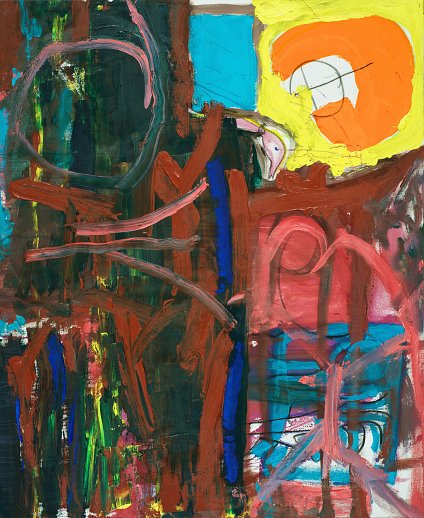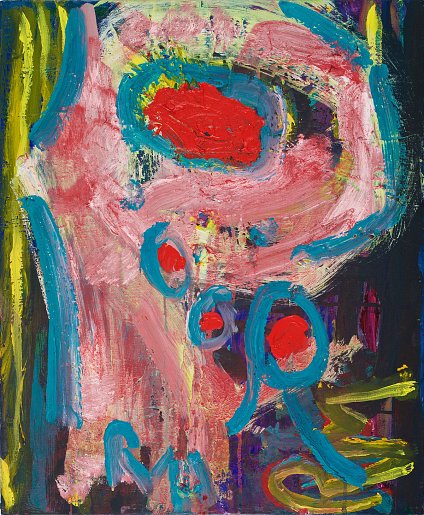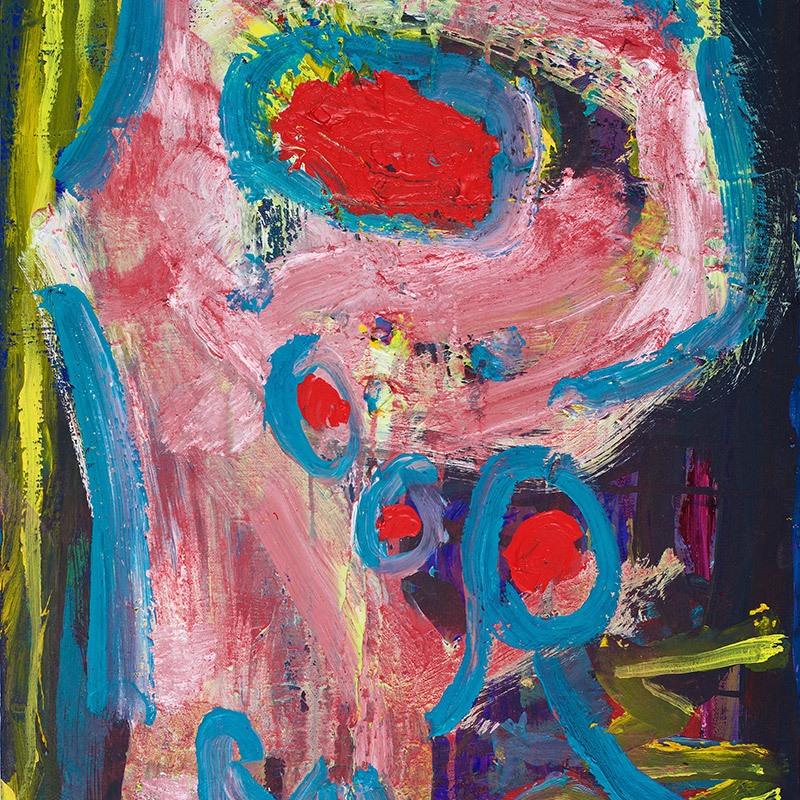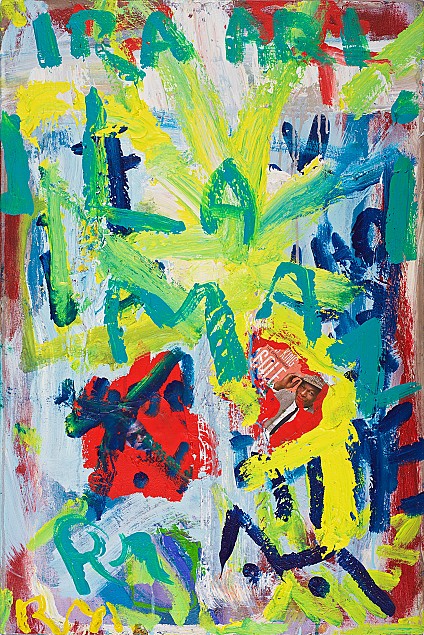Untitled 2015
An Action in Oils
by Madeleine K Snow
I am sitting looking out at the sea, at a horizon line interrupted by bulk carriers, torn between enjoying the view and imagining it without the coal ships, whilst trying to block out the noise of my pet duck disrupting my thoughts. It is a typical Newcastle vista, where nature is almost corrupted by industry and one in which the quack only adds to a sense of unease. This disquieting scenario seems apt to discuss the work of artist Ross Mullane born in Newcastle, Australia of Irish heritage in 1949, for all is not quite as it seems. Yes he is passionate about colour, his craft, the act of painting, but he is also angry, fired up, frustrated even by the world in which he lives. His punk aesthetic challenges and provokes. The canvas is a ground on which to explore an idea. His works are layered, intuitive, bold and deliberately oblique. He wants his audience to be jolted, to respond, to the visceral colour and the physicality of the painting.
In many ways he is an outsider artist, refusing to bow to convention such as naming a work preferring for the painting to speak for itself. Perceiving these points of entry as a convention he would prefer to break. Likewise he doesn’t want to repeat himself or be locked in by the tyranny of a single identifying image. Yet there are recurring threads in the work of Ross Mullane. For example abstraction, text and colours which reappear such as,cobalt blue used as raw pigment, ultramarine blue, magenta, and chartreuse yellow (named after French liquor). Likewise the artworks tend to have layered surfaces built up by paint, time and sometimes collage.
The performative gesture of action painting is evident in the work of Mullane, a debt to the CoBrA group and the Abstract Expressionists. He intentionally places good quality watercolour paper on the floor of his studio in the hope of creating a new work from the fabric of the former. The trace of his process is captured in the flicked, splattered dripped colours caught on the watercolour paper. The very act of painting is revealed through these pieces. His studio basement is a testimony to his enthusiasm for his craft, filled with paintings, pigment, tubes of paints not dissimilar to the recently relocated studio of the late Francis Bacon (1909-1992). Mullane says he is always painting it is a daily activity.

2015-04-21
Untitled
1.2m x 0.8m
Acrylic Pencil

2015-10-22
Untitled
900cm x 900cm
Oil, Oil Stick on canvas

2017-04-21
Poor
620cm x 780cm
Oil
Bad Language
His bad language paintings are about expressing a sentiment. He went to St Pius school in Newcastle during the years that paedophilia was rampant and repressed. [Reportedly in a case receiving media attention in recent years the paedophile priest worked at the school for nearly twenty years unchecked from 1968-1986. He wasn’t jailed until 2010.] Although not directly a victim he watched as others around him were changed by the situation. Naturally he feels despondent towards the Catholic Church angry at the years of sanctioned priests and silenced children. Cathartic and political, his paintings are a vehicle for his emotions and ideas.
The work inscribed “peace” in cyan blue is like a piece of street art as if built up over time by varying artists.There are scrawls with attitude of the words “Pea…” “Peace”. A caricatured head you might find on a surfers t-shirt or Basquiat painting. Symbols like suns, x’s, suggestions of images all vying for attention. Between abstraction and figuration they are scraped back, hidden, layered and built up like the cracking paint on a laneway wall. The work is busy and energetic. The blues are harmonious- ‘peaceful’ whilst the splashes of red, orange, yellow, green are counterpoints to the calm, indicating the struggle and the conundrum of the inscription.
Mullane is a leftie, compassionate, hard drinking, roll your own tobacco smoking artist. He paints about issues he cares about, these are diverse, complex, as varied as the human psyche. Born by the ocean he surfs less now but has enjoyed a life of surfing, gardening, and currently the changing skies over Botany Bay. He lives and breathes his painting.Working in his “subterranean”studio, a daily ritual. A quote referring to the abstract painter Tony Tuckson (1921-1973) seems pertinent to the works of Ross Mullane. “Over time this singular abstract mark came to look like a self-portrait or perhaps a perceptive physical self-description of the painter – his size, balance and, remarkably, his state of mind.
When considered as a group the works explore a range of emotions: anger, outrage, joy, quiet, solace, freedom, and rupture. The painted slogans are like the traces of a protest march, a rally bursting with ideologues, part diatribe- an action in oils. Mullane has used the most permanent and traditional of mediums oil on canvas for these apparent ‘throw away lines’. The irony and intention, that the mark he inscribes ‘help the poor’, ’black poverty’ ‘shame’, ‘shirt lifters’, ‘tax the pigs’, will reverberate.

2015-04-21
Untitled
820cm x 890cm
Oil on canvas
Image and text in art history has been often aligned with conceptual art think Magritte’s (1898-1967) ‘The Treachery of images’ Ceci n’est pas une pipe or Joseph Kosuth’s (1945-) ‘One and three chairs’ 1965 a photograph, a document, the object itself, these works were driven by a desire to explore the philosophy of Semiotics to question the ‘reading’ of images. By contrast artists like the Dadaists, the Cubists, the Neo Dadaist Robert Rauschenberg (1925-2008), Jean-Michel Basquiat (1960-1988) amidst the New York punk scene of the 1980s used it expressively, satirically, personally and politically. In the antipodes artists such as Robert Macpherson (1937-) and Colin McCahon (1919-1987) through to this year’s winner of the Sulman Prize Jason Phu (1989-)in his work entitled “I was at yum cha when in rolled the three severed heads of Buddha: Fear, Malice and Death” pick up this mantle. So too Ross Mullane inscribes his canvases in expressive text which slips between abstraction and figuration.
If we consider handwriting contains the duality of communicating a message and expressing the writer’s identity, Mullane is revealing much on the canvas. In ‘Help the poor’ the text blinks like an eye. If a sign, is it a call to arms? Or a slogan, weighty with regret, invoking the at times misguided alms of Christians? The word ‘poor’ is animated, painterly, executed as his abstract paintings with the same vigorous energy and vibrant colour, sparkling, blinking, confronting. His text paintings allude to history and politics with messages which are intuitive, part memoire, persuasive, and combative. Exploring personal narratives and literally speaking to his audience.
In his abstract in chartreuse yellow and cobalt blue it is the intensity of the colours that make the work sing. This could be a seascape the blinding yellow of sand the slash of cobalt blues with a hint of red and green to counter the work. These abstracts are energetic and vivid, expansive in their sweeps of colour. He cites music as inspiration for his paintings the staccato of jazz is evident in the works as is the romance of classical music.
Mullane has travelled widely and exhibited in both the UK and Australia. His work is represented in private collections across the UK, USA, Sweden and Australia as well as The University of Liverpool Gallery, Maitland Regional Gallery and Newcastle Region Art gallery NSW. Today he lives and works in Malabar Sydney overlooking the industry of Botany Bay.
Written by Madeleine K Snow. 2016
- Article by James Madden July 3rd 2010 date cited 17/7/15
- http://www.theaustralian.com.au/news/nation/pedophile-priest-jailed-for-sadistic-sexual-abuse-of-schoolboys/story-e6frg6nf-1225887316692 “Article by James Madden”
- Inspired by the NY Hip hop music scene and protégé of Andy Warhol, Jean Michel Basquiat brought street culture to the gallery walls.
- Lewis, Ruark. Ross Mullane New Work Preview, Catalogue , Codey 2012, p7.
- Fisher, Tim. http://nga.gov.au/Tuckson/ date cited 22/6/2015





